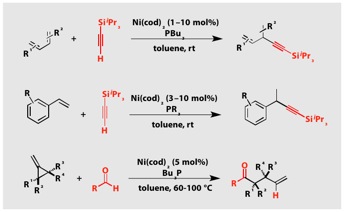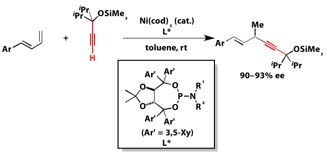New catalytic C-H Functionalization Reactions
With recognition of the importance of direct catalytic C-H functionalization for the development of “green” production processes, we also make efforts to the development of new C-H functionalization reactions.
4.1. Catalytic Addition of C-H Bond to C=C Bonds †
We are particularly interested in the addition of alkyne-C–H bond to C=C bonds, which has been unexplored. In the presence of nickel catalysts, additions of terminal alkyne to 1,3-dienes, styrenes, and methylenecyclopropanes were developed (J. Am. Chem. Soc. 2008, J. Am. Chem. Soc. 2009). The hydroalkynylation of 1,3-dienes has been extended to asymmetric catalysis with up to 93% ee (Angew. Chem., Int. Ed. 2010). Moreover, one step conversion of a variety of aldehydes into γ,δ-unsaturated ketones has been accomplished by nickel catalyzed hydroacylation of methylenecyclopropanes (J. Am. Chem. Soc. 2009).
4.2. Removable o-Directing Group for Organoboronic Acids †
We are also interested in directed C-H activation in which directing groups play key roles in the enhancement of reaction rate as well as regioselectivity. We have recently established easily attachable and removable directing group for arylboronic acids. 2-Pyrazol-5-ylaniline efficiently undergoes condensation with arylboronic acids, giving ArB(pza) derivatives as shown in the following scheme (J. Am. Chem. Soc. 2009). The pza group serves as an ortho-directing group in the ruthenium catalyzed o-C–H silylation. This is the first demonstration of the attachment of directing group on the easily convertible substituents such as a boronyl group. We recently established more efficient removable directing group, AAM (anthranilamide) (Org. Lett. 2011).
4.3. C-H Activation at the Methyl Groups on Silicon †
More recently, we established selective C-H borylation of methyl groups on the silicon atom (J. Am. Chem. Soc. 2012). In spite of the steric bulkiness of the silyl groups, the methyl group on silicon is selectively converted to borylmethyl groups, of which the boryl group serve as convenient handle for further transformation. This new C-H borylation allowed us to functionalize chloromethylsilanes, which are major starting materials in silicone industry produced by the Rochow direct process, being recognized as the first catalytic process in which the methyl groups of the chloromethylsilanes are converted selectively, leaving the chlorine on the silicon atom intact. Highly inert tetramethylsilane also undergoes the C-H borylation at its methyl group.


